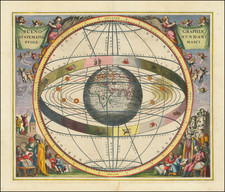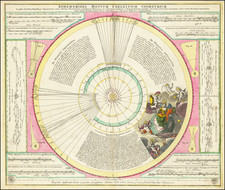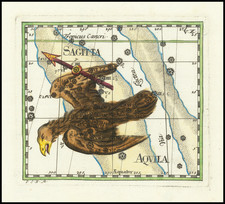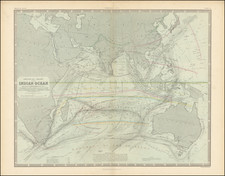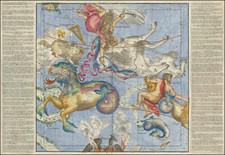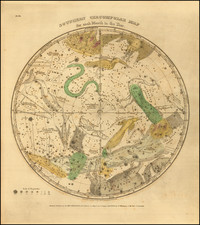Fine old color example of Cellarius's chart illustrating Claudius Ptolemy's earth-centered model of the universe.
In the second century, Claudius Ptolemy, an important Egyptian Astronomer and Geographer, postulated that the Sun and Planets revolved around the Earth, which was at the center of the universe. Cellarius shows Ptolemy's earth-centric model, with the signs of the zodiac ringing the earth and surrounded by allegorical scenes including a celestial globe, classical astronomers working with globes and instruments.
At first glance, the chart is striking in its vibrant colors and detailed depictions. Dominating the center is a geocentric representation of the Earth, a hallmark of the Ptolemaic system, where the Earth is conceived as the center of the universe. Surrounding the Earth are intricate trajectories showcasing the orbits of the Moon and planets, including Saturn, Jupiter, Mars, Venus, and Mercury. Each orbit is labeled, offering insights into the understanding of the solar system in the 17th century.
The map is bordered by beautifully illustrated scenes. To the left and right upper corners, cherubic angels hold drapery banners proclaiming the title of the map and elaborating on the Ptolemaic understanding of the universe. Beneath these, a series of smaller cherubs play, float, and interact with various celestial instruments, signifying the scientific and divine nature of astronomy during this period.
The bottom scene juxtaposes the mundane and the celestial. On the left, a well-built town represents modern astronomy. On the right, scholars and astronomers gather in discussion amidst decaying ruins of a town. This is typically taken to represent the ancient and disproven astronomical theories.
States of the Map
- State 1: 1660
- State 2: 1661, plate number in lower right corner.
- State 3: 1708, imprint of Valk & Schenk added.
Andreas Cellarius was born in 1596 in Neuhausen and educated in Heidelberg. He emigrated to Holland in the early 17th century, and in 1637 moved to Hoorn, where he became the rector of the Latin School. Cellarius' best-known work is his Harmonia Macrocosmica, first issued in 1660 by Jan Jansson, as a supplement to Jansson's Atlas Novus. The work consists of a series of Celestial Charts begun by Cellarius in 1647 and intended as part of a two-volume treatise on cosmography, which was never issued.

